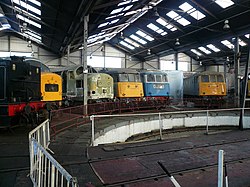
The British Rail Class 55, also known as a Deltic, or English Electric Type 5, is a class of diesel locomotive built in 1961 and 1962 by English Electric for British Railways. Twenty-two locomotives were built, designed for the high-speed express passenger services on the East Coast Main Line (ECML) between Edinburgh and London King's Cross. They gained the name "Deltic" from the prototype locomotive, DP1 Deltic, which in turn was named after its Napier Deltic power units. At the time of their introduction into service in 1961, the Class 55s were the most powerful single-unit diesel locomotives in the world, with a power output of 3,300 hp (2,500 kW). They had an official maximum speed of 100 miles per hour (160 km/h), and introduced the first regular 100 mph diesel passenger service to Britain, they were however capable of higher speeds than this, and often exceeded their official maximum in service, especially in their later years, with speeds of up to 117 miles per hour (188 km/h), being recorded on level gradients, and up to 125 miles per hour (201 km/h) whilst descending Stoke Bank.

The British Rail Class 02 are a class of twenty 0-4-0 diesel-hydraulic shunting locomotives built by the Yorkshire Engine Company in 1960 and 1961 (D2860-D2869) for service in areas of restricted loading gauge and curvature such as docks. They had the door to the cab at the rear, with a railed veranda behind the cab; this feature was very unusual on British Rail locomotives, although it was used on many Yorkshire Engine Co. designs and is quite normal in North American practice.
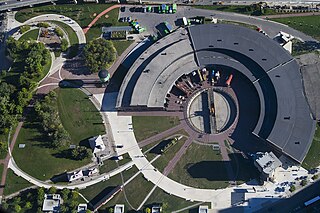
A railway roundhouse is a building with a circular or semicircular shape used by railways for servicing and storing locomotives. Traditionally, though not always the case today, these buildings surrounded or were adjacent to a turntable.
Peak Rail is a preserved railway in Derbyshire, England, which operates a steam and heritage diesel service for tourists and visitors to both the Peak District and the Derbyshire Dales.

The Midland Railway – Butterley is a heritage railway and museum complex at Butterley, near Ripley in Derbyshire.

Rutland Railway Museum, now trading as Rocks by Rail: The Living Ironstone Museum, is a heritage railway on part of a former Midland Railway mineral branch line. It is situated north east of Oakham, in Rutland, England.

The Northamptonshire Ironstone Railway Trust operates a 1+1⁄2-mile (2.4 km) long heritage railway line at Hunsbury Hill, south-west of Northampton. The line is mainly dedicated to freight working, featuring many sharp curves and steep gradients which were typical of the industrial railway, but rides are available in a variety of vehicles including a converted brake van.

DP2, meaning Development Prototype number 2, was a prototype Type 4 mainline diesel locomotive, built by English Electric in 1962. DP2 was effectively the prototype for the later Class 50; it trialled the engine and electronic systems later used in that class of locomotives.

The East Anglian Railway Museum is located at Chappel and Wakes Colne railway station in Essex, England, which is situated on the former Great Eastern Railway branch line from Marks Tey to Sudbury. Services on the Sudbury Branch Line are operated by Abellio Greater Anglia.
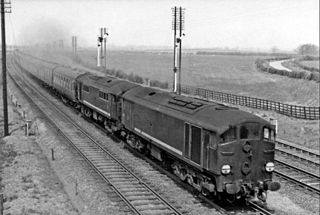
The British Rail Class 28 diesel-electric locomotives, known variously as 'Metrovicks', 'Crossleys' or 'Co-Bos', were built under the Pilot Scheme for diesel locomotives as part of the British Railways 1955 Modernisation Plan.
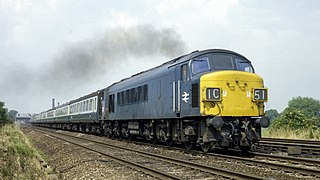
The British Rail Class 45 or Sulzer Type 4 are diesel locomotives built by British Railways' Derby and Crewe Works between 1960 and 1962. Along with the similar Class 44 and 46 locomotives, they became known as Peaks.

The Midland Railway 1377 Class was a class of 185 0-6-0T tank locomotives. They were introduced in 1878 by Samuel W. Johnson, and were almost identical to the 1102 class of 1874; the latter having fully enclosed cabs, while the 1377 class were built without a rear to the cab and only a short cab roof, hence their nickname "half-cabs". They were given the power classification 1F.

The Midland Railway 156 Class was a class of 2-4-0 tender engines built at Derby Works between 1866 and 1874. In total 29 of the class were built under the Midland Railway. They were rebuilt sometime between 1873 and 1903.

The British Rail Class 23 were a class of ten Bo-Bo diesel-electric locomotives built by the English Electric Company (EE) in 1959. The power unit used was a Napier Deltic T9-29 9-cylinder engine of 1,100 bhp (820 kW) driving an EE generator, which powered the four traction motors. They were numbered from D5900 to D5909.
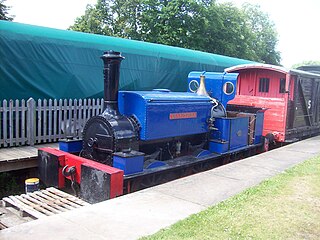
Manning Wardle was a steam locomotive manufacturer based in Hunslet, Leeds, West Yorkshire, England.

Staveley Central was a railway station serving the town of Staveley, Derbyshire, England.

Barrow Hill railway station is a former railway station in the village of Barrow Hill in northern Derbyshire, England.
There were a number of engine sheds and railway works located in York. The large York North engine shed became the National Railway Museum in 1975.
The Great Central Railway (Nottingham) (formerly known as the Nottingham Heritage Railway) is a heritage railway located at the Nottingham Transport Heritage Centre (NTHC), on the south side of the village of Ruddington, in Nottinghamshire. The route consists of almost 10 miles (16 km) of the former Great Central Main Line from Loughborough South Junction (with the Midland Main Line) to Fifty Steps Bridge and the site of Ruddington's former GCR station, plus a branch line from Fifty Steps Bridge to Ruddington Fields station which is located on a former Ministry of Defence site next to Rushcliffe Country Park.
The Midland Railway 1134A Class was a class of 0-4-0ST steam locomotives. They were a development of the preceding 1116A Class, but were generally larger in most dimensions. The subsequent 1528 Class was effectively a side tank version of this class.
